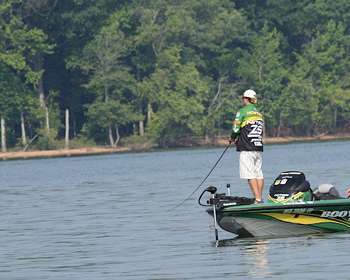
Hailing from Alabama, a state rich with lakes noted for outstanding structure fishing, Tim Horton has had ample opportunity to refine his offshore skills. During late fall and early winter, the Elite Series pro often targets underwater humps to catch bass that are holding on the deep water structure.
Horton's success when fishing main lake humps usually hinges around one thing: current.
"Current will dictate where the bass are located on the hump," he explains. "I usually look for humps that are located in the main lake because that's where the current is generally the strongest." Horton is quick to point out that current flow can be created from a variety of factors, including power generation, wind and high water.
"I fished a tournament on Toledo Bend in which the direction that the wind was blowing each day dictated where the bass would set up on the humps," recalls Horton.
When searching for productive humps on the main lake, Horton looks for ones that feature a hard bottom and a pronounced break on one end. "When I can find a sharp break on the upstream side of the current, it tells me that there is going to be a firm bottom because it hasn't rounded off and washed away. So it's probably going to be a rock bottom," he says.
If the main channel swings close to the hump, the structure can be even sweeter. "A hump located right on the main channel guarantees that there will be a sharp drop and deep water nearby," says Horton. "It's not a necessity, but it is something that I always like to look for."
Often void of distinct features, humps may seem like a prime place to drop brushpiles. However, Horton explains that this is not always the case. When fishing current-driven reservoirs, the addition of brushpiles can actually hurt an already productive hump. "The bass will position on the humps because of the current breaks. When you add brush, it changes the current flow." says Horton. When fishing highland reservoirs without current, Horton is more likely to target humps with brush.
Boat positioning is also an important aspect of effectively fishing main lake humps. For Horton, it all depends on depth. If he is targeting a hump in less than 25 feet of water, the Alabama pro stays away from the hump and casts to it to reduce the chances of spooking bass. In water deeper that 25 feet, he positions his boat over the structure. "If it's deeper than 25 feet, I like to fish vertically with either a drop shot or a spoon," he explains.
"In the winter time, bass will hold tight to the bottom in deep water, especially on clear water lakes. You can sit over them with a spoon or a drop shot and really catch them."




